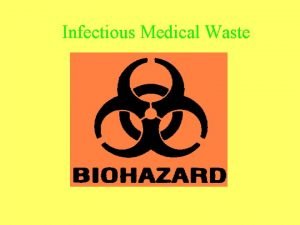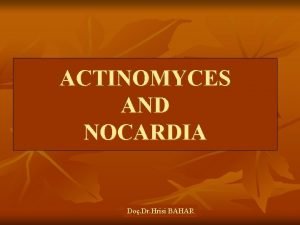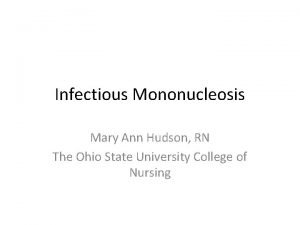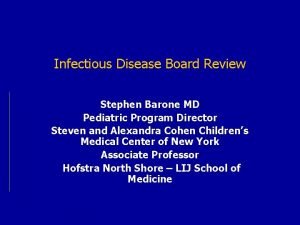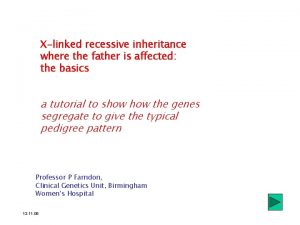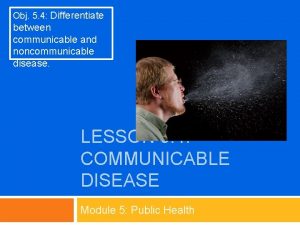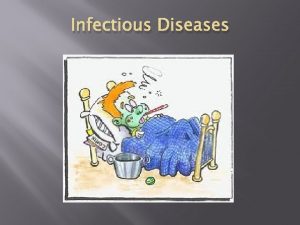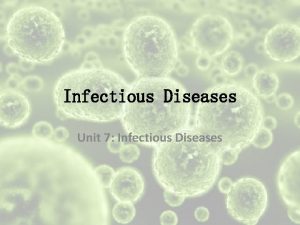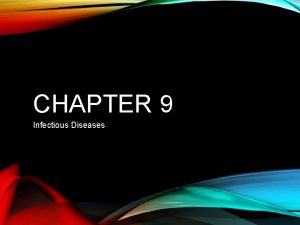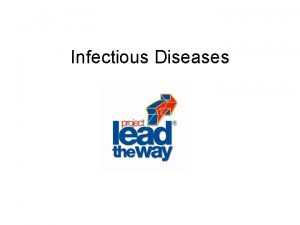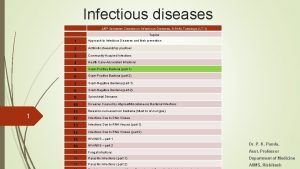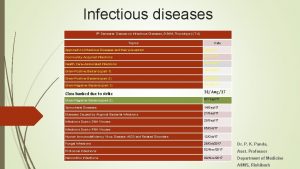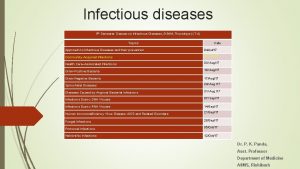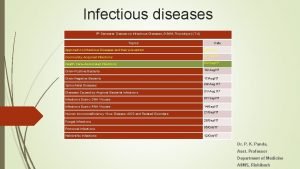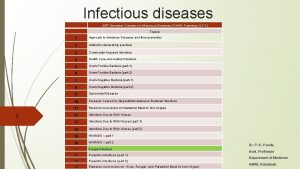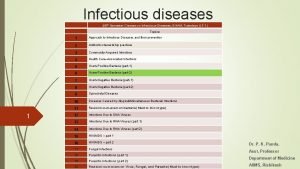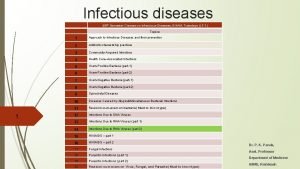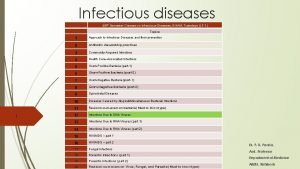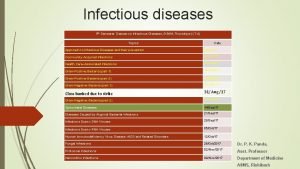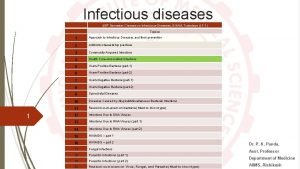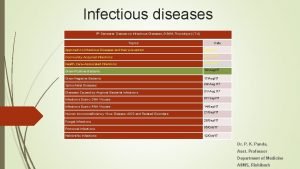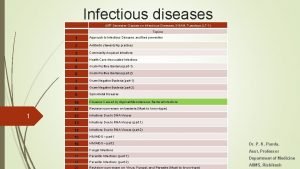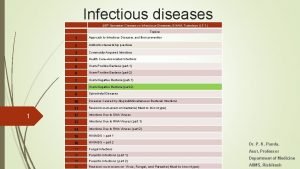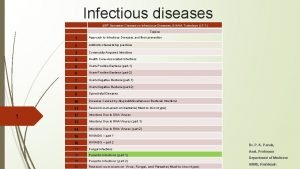Infectious diseases 45 th Semester Classes on Infectious






























- Slides: 30

Infectious diseases 4/5 th Semester Classes on Infectious Diseases, 8 -9 AM, Tuesdays (LT-1) Topics 1 1 Approach to Infectious Diseases and their prevention 2 Antibiotic stewardship practices 3 Community-Acquired Infections 4 Health Care–Associated Infections 5 Gram-Positive Bacteria (part-1) 6 Gram-Positive Bacteria (part-2) 7 Gram-Negative Bacteria (part-1) 8 Gram-Negative Bacteria (part-2) 9 Spirochetal Diseases 10 Diseases Caused by Atypical/Miscellaneous Bacterial Infections 11 Revision-cum-exam on bacteria (Must to know type) 12 Infections Due to DNA Viruses 13 Infections Due to RNA Viruses (part 1) 14 Infections Due to RNA Viruses (part 2) 15 HIV/AIDS – part 1 16 HIV/AIDS – part 2 17 Fungal Infections 18 Parasitic Infections (part 1) 19 Parasitic Infections (part 2) 20 Revision-cum-exam on Virus, Fungal, and Parasite (Must to know type) Dr. P. K. Panda, Asst. Professor Department of Medicine AIIMS, Rishikesh

HIV/AIDS • HIV is a retrovirus which attacks the T-cells in the immune system • Acquired Immuno deficiency syndrome or AIDS, is a collection of symptoms due to underlying infections and malignancies resulting from specific damage to immune system caused by human immunodeficiency virus (HIV).

AGlobal view of HIVInfection • Approximately > 40 million people are currently living with HIV infection, and 25 million have already died


AIDS • The first indication of this new syndrome came in 1981 in homosexual drug addict males; • They had two things in common- Pneumocystis pneumonia and Kaposi’s sarcoma • In 1983, HIV was isolated from a patient with lymphadenopathy, and by 1984 it was demonstrated clearly to be the causative agent of AIDS • In 1986, The International Committee on virus Nomenclature decided on the generic name of the causative virus as the Human Immunodeficiency Virus


Structure of HIV • It hasadiameter of 100 -120 nm with aspherical morphology • Cone-shaped core surrounded bylipid matrix containing key surface antigens and glycoproteins • Viral core contains 2 copies of genomic RNA, reverse transcriptase, integrase and protease

Based on molecular and antigenic differences, two types of HIV have been recognized HIV 1 HIV 2 • HIV-1 is more commonin india • Easily transmitted. • Pathogenic in nature • Duration of infection is quite long. • classified in to at least ten subtypes based on sequence analysis of their gag and env genes (Group M (For major) is largest. • HIV-2 is found in West Africa, Mozambique, and Angola. • Lesseasily transmitted. • Less pathogenic. • Duration of infection is shorter. • Relatively rare and hasnot been reported from India.

Antigenic variations in HIV • HIV is a highly mutable virus and exhibits frequent antigenic variations as well as differences in other features such as nucleotide sequences, cell tropism, growth characteristics and cytopathology • Not only are there differences between isolates of HIV from different races or persons but also between sequential isolates from the same person, and even between those obtained from different sites of the same person at the same time. • This great variability is believed to be due to error prone nature of reverse transcription

Mode of transmission 1. Sexual contact- In 75 % cases , transmission is by sexual contact. • People who already have a sexually transmitted disease, such as syphilis, genital herpes, chlamydial infection, gonorrhea, or bacterial vaginitis, are more likely to acquire HIVinfection during sex with an infected partner

Mode of transmission 2. Parenteral- In 15 % cases, it is by blood transfusion or blood product transfusion. 3. Sharing of unsterilized needles or syringes in drug addicts contaminated with blood from an infected person can spread virus. 4. HIV can be spread in health-care settings through accidental needle sticks or contact with contaminated fluids. 5. HIV can also spread through organ transplantation. 6. Mother to child

From mother to child • 30% of children born to infected mothers have the acquired infection unless virus is treated by antiviral drugs before pregnancy. • In nursing mothers transmission can occur through breast milk.

Pathogenesis CD 4+cells are present in- T helper cells, B-lymphocytes , macrophages, monocytes , and dendritic cells

Steps of viral entry in to the host cell o Strains of HIV that utilize CCR 5 as a co-receptor are referred to ase macrophag tropic viruses (M –tropic viruses) o Strains of HIV that utilize CXCR 4 are referred to as T tropic viruses. o Many virus strains are dual tropic in that they utilize both CCR 5 and CXCR 4.


Events that transpire from primary HIV infection

Summary of early events in HIV infection

• Lymphoid tissues are the major anatomic sites for the establishment and propagation of HIV infection • Immune activation and inflammation contribute substantially to: (1) the replication of HIV, (2) the induction of immune dysfunction, and (3) the increased incidence of chronic conditions associated with persistent immune activation and inflammation • Accelerated aging syndrome • Bone fragility • Cancers • Cardiovascular disease • Diabetes • Kidney disease • Liver disease • Neurocognitive dysfunction

Increased occurrence and/or exacerbation of certain autoimmune diseases like: • Psoriasis, • Idiopathic thrombocytopenic purpura, • Graves’ disease, • Antiphospholipid syndrome, and • Primary biliary cirrhosis Immune reconstitution inflammatory syndrome (IRIS) is an autoimmune-like phenomenon characterized by a paradoxical deterioration of clinical condition, which is usually compartmentalized to a particular organ system, in individuals in whom c. ART has recently been initiated. • It is associated with a decrease in viral load and at least partial recovery of immune competence, which is usually associated with increases in CD 4+ T cell counts. • Commonly seen with underlying Mycobacterium tuberculosis and cryptococcosis

Immune deficiency in HIV Infection

Typical course of an untreated HIV-infected individual (The combination of viral pathogenic and immunopathogenic events decides the disease)

• Long-term nonprogressors are by definition long-term survivors; however, the reverse is not always true • Long-term nonprogressors were first described in the 1990 s, defined if • They had been infected with HIV for a long period (≥ 10 years), • Their CD 4+ T cell counts were in the normal range, and • They remained stable over years without receiving Cart

Laboratory Diagnosis of HIV infection 1) Non Specific Tests- The following tests help to establish the immunodeficiency in HIV infection. • Total Leukocyte and lymphocyte count- to demonstrate leucopenia and lymphopenia. The lymphocytic count is usually below 2000/mm 3 • T cell subset Assays- Absolute CD 4+ cell count is reduced with T 4 : T 8 ratio is reversed • Platelet count-shows Thrombocytopenia. • Ig. A and Ig Glevels are raised • Diminished cell mediated Immunity as indicated by skin tests • Lymph node biopsy shows profound abnormalities

Laboratory Diagnosis of HIV infection 2. Specific Tests for HIVinfection- Diagnosis depends on the demonstration of antibodies to HIV and/or the direct detection of HIV or one of its components Detection of antigen - p 24 Capture ELISA assay, is positive in about 30% of the infected persons. • In the first few weeks after infection and in the terminal phase, the test is uniformly positive Detection of antibodies - It takes 2 -8 weeks to months for the antibodies to appear in circulation Recently, the interval between infection and detection (window period) has decreased from 22 days for antibody testing to 16 days with p 24 antigen testing and subsequently to 12 days with NAT

Laboratory Diagnosis of HIV infection ELISA (most frequently used method for screening for HIV antibody) 1)First generation - whole viral lysates 2)Second generation - recombinant antigen 3)Third generation - synthetic peptide 4)Fourth generation - antigen + antibody (Simultaneous detection of HIV antigen and antibody) - HIV duo

Laboratory Diagnosis of HIV infection Supplemental Tests • Western Blot Test (gold standard) • Indirect Immunoflorescence test • Radio Immuno. Precipitaion Assay Rapid Tests a) Dot Blot assay b) Particle Agglutination tests c) HIV spot and comb test d) Flurimetric microparticle techn

Laboratory Diagnosis of HIV infection Demonstration of viral Nucleic acid • Three different PCR techniques namely • RT- PCR, • Nucleic acid sequence based amplification (NASBA) and • branched-DNA (b-DNA) assay have been employed to develop commercial kits Extremely high sensitivity


Clinical Manifestations The center for disease control (CDC) has classified the clinical course of HIV infection under various groups. 1. Acute HIVinfection 2. Asymptomatic or Latent infection 3. Persistent generalized lymphadenopathy (PGL) 4. AIDSrelated complex 5. Full blown AIDS(Last stage)

Thank you
 Epidemiological triad
Epidemiological triad Icd 10 morbus hansen
Icd 10 morbus hansen Classe e subclasse de palavras 7. ano
Classe e subclasse de palavras 7. ano Pre ap classes vs regular classes
Pre ap classes vs regular classes Infectious waste management
Infectious waste management Hpps symbols
Hpps symbols Stages of infectious disease
Stages of infectious disease Infectious disease
Infectious disease Papillomitosis
Papillomitosis Infectious disease quality controls
Infectious disease quality controls Noncellular infectious protein particles are called
Noncellular infectious protein particles are called Infectious canine hepatitis in dogs
Infectious canine hepatitis in dogs Ebv
Ebv Infectious nucleic acid
Infectious nucleic acid Periods of infectious disease
Periods of infectious disease Infectious stunting syndrome
Infectious stunting syndrome Stridor
Stridor Hennepin county infectious disease manual
Hennepin county infectious disease manual Lead poisoning
Lead poisoning Chapter 26 infectious disease prevention and control
Chapter 26 infectious disease prevention and control Smallest infectious agents
Smallest infectious agents X linked diseases
X linked diseases Difference between communicable and noncommunicable
Difference between communicable and noncommunicable Chapter 15 nervous system diseases and disorders
Chapter 15 nervous system diseases and disorders Diseases in civil war
Diseases in civil war Venn diagram of communicable and non-communicable diseases
Venn diagram of communicable and non-communicable diseases Chapter 6 musculoskeletal system
Chapter 6 musculoskeletal system Diseases of the musculoskeletal system
Diseases of the musculoskeletal system Modern lifestyle and hypokinetic diseases
Modern lifestyle and hypokinetic diseases Chapter 23 lesson 1 understanding communicable diseases
Chapter 23 lesson 1 understanding communicable diseases 10 nail diseases and disorders
10 nail diseases and disorders




